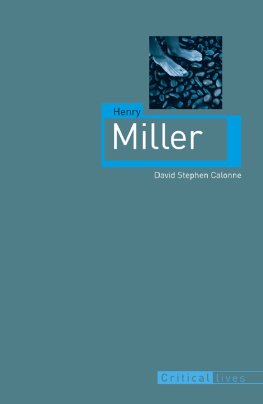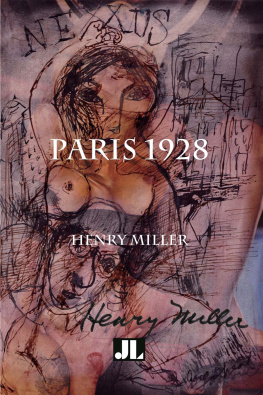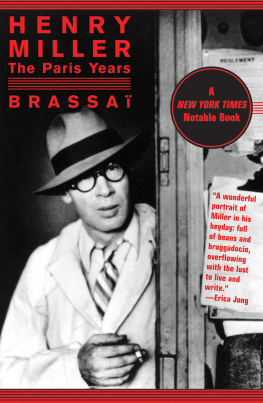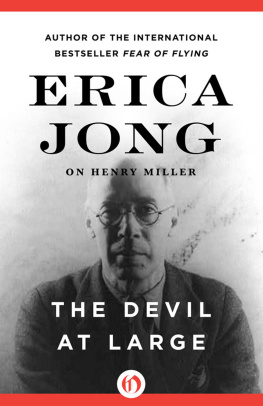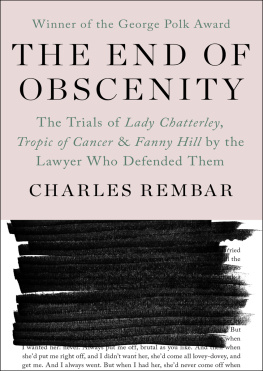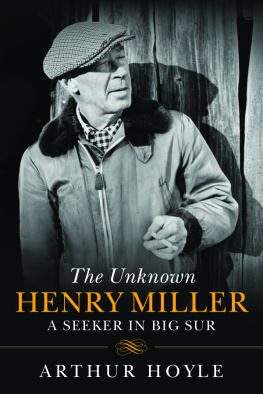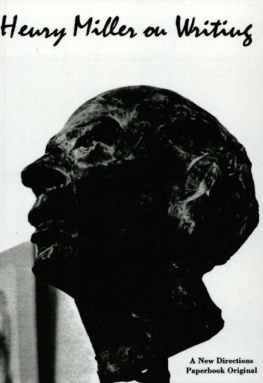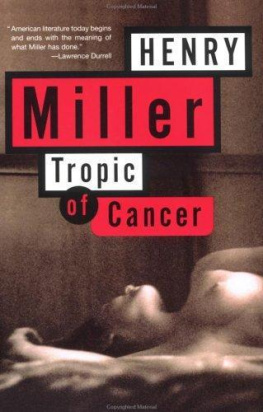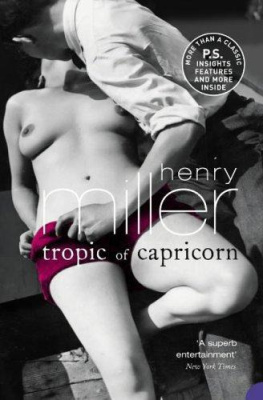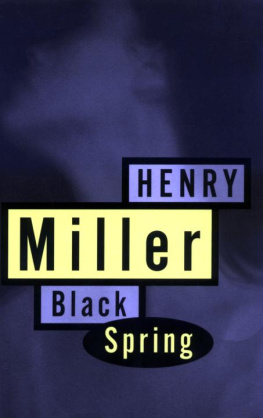Henry Miller

Titles in the series Critical Lives present the work of leading cultural figures of the modern period. Each book explores the life of the artist, writer, philosopher or architect in question and relates it to their major works.
In the same series
Georges Bataille Stuart Kendall Charles Baudelaire Rosemary Lloyd Simone de Beauvoir Ursula Tidd Samuel Beckett Andrew Gibson Walter Benjamin Esther Leslie John Berger Andy Merrifield Jorge Luis Borges Jason Wilson Constantin Brancusi Sanda Miller Bertolt Brecht Philip Glahn Charles Bukowski David StephenCalonne William S. Burroughs Phil Baker John Cage Rob Haskins Fidel Castro Nick Caistor Coco Chanel Linda Simon Noam Chomsky Wolfgang B. Sperlich Jean Cocteau James S. Williams Salvador Dal Mary Ann Caws Guy Debord AndyMerrifield Claude Debussy David J. Code Fyodr Dostoevsky Robert Bird Marcel Duchamp Caroline Cros Sergei Eisenstein Mike OMahony Michel Foucault DavidMacey Mahatma Gandhi Douglas Allen Jean Genet Stephen Barber Allen Ginsberg Steve Finbow Derek Jarman Michael Charlesworth Alfred Jarry Jill Fell James Joyce Andrew Gibson Carl Jung Paul Bishop Franz Kafka Sander L. Gilman Frida Kahlo Gannit Ankori Yves Klein Nuit Banai Lenin Lars T. Lih Stphane Mallarm RogerPearson Gabriel Garca Mrquez Stephen M. Hart Karl Marx Paul Thomas Eadweard Muybridge Marta Braun Vladimir Nabokov Barbara Wyllie Pablo Neruda Dominic Moran Octavio Paz Nick Caistor Pablo Picasso Mary Ann Caws Edgar Allan Poe Kevin J. Hayes Ezra Pound Alec Marsh Marcel Proust Adam Watt Jean-Paul Sartre Andrew Leak Erik Satie Mary E. Davis Arthur Schopenhauer Peter B. Lewis Susan Sontag Jerome Boyd Maunsell Gertrude Stein Lucy Daniel Richard Wagner Raymond Furness Simone Weil Palle Yourgrau Ludwig Wittgenstein Edward Kanterian Frank Lloyd Wright Robert McCarter
Henry Miller
David Stephen Calonne
REAKTION BOOKS
In memoriam
Mariam Galoostian
Armenian mystic
Magna Mater
Published by Reaktion Books Ltd
33 Great Sutton Street
London EC1V 0DX, UK
www.reaktionbooks.co.uk
First published 2014
Copyright David Stephen Calonne 2014
All rights reserved
No part of this publication may be reproduced, stored in a retrieval system, or transmitted, in any form or by any means, electronic, mechanical, photocopying, recording or otherwise, without the prior permission of the publishers
Page references in the Photo Acknowledgments and
Index match the printed edition of this book.
Printed and bound in Great Britain by Bell & Bain, Glasgow
A catalogue record for this book is available from the British Library
eISBN 9781780233994
Contents

Henry Miller, Big Sur (1957).
Paradise in the 14th Ward, 18911908
Henry Miller was born at approximately 12:17 p.m. on 26 December 1891 at 450 East 85th Street in Yorkville, Manhattan. In his great autobiographical romance Tropic of Capricorn (1939), he pondered the time:
Slated for Christmas I was born a half hour too late. It always seemed to me that I was meant to be the sort of individual that one is destined to be by virtue of being born on the 25th day of December... But due to the fact that my mother had a clutching womb, that she held me in her grip like an octopus, I came out under another configuration with a bad setup in other words... One thing seems clear, however and this is a hangover from the 25th that I was born with a crucifixion complex. That is, to be more precise, I was born a fanatic.
In The Nightmare Notebook (written 194041, published 1975) he reflected further on his origins: Note: I was born just under the line 1891, Dec. 26th. No wonder I have the Equator complex! Cancer, Capricorn, Draco and the Ecliptic, etc. The Dark Night of the Soul! The Grand Pralaya.
In 1892, when Henry was one year old, the Miller family moved from Yorkville to Williamsburg the north Brooklyn neighbourhood across the East River from the Lower East Side of Manhattan, about three miles from where Walt Whitman had lived, and which Miller always referred to as The 14th Ward. The streets were cobblestone and automobiles were still a rarity.
Both Millers grandfathers were among those seeking a new life; and both were fleeing from military service in Germany.
Miller described his childhood in stark before-and-after terms: a pre- and post-lapsarian imaginative universe with Paradise located in Williamsburg, the 14th Ward. Millers favourite areas to play in were North First Street, the block between Driggs and Bedford Avenues; and Fillmore Place, the block from Roebling Street to Driggs. He would return obsessively to these early memories in many of his works: Black Spring, Tropic of Capricorn, The Books in My Life and The Book of Friends. There is perhaps some irony in the fact that Miller became world famous for his supposedly obscene and pornographic works, while in fact one of his greatest subjects is the transcendence and joy of childhood.
One of his earliest memories at age four was seeing the corpse of a frozen cat in the gutter his first encounter with death, and birds singing in the cage and I was in the high chair and I recited poems in German. I knew German before I knew English.
Yet these tender, nostalgic memories are balanced by the brutal discipline inflicted on children. In the nearby community of Ridgewood, where Miller would spend time with his cousin, he remembered the German Americans as a despicable lot the kind who later made good Nazis.
Millers cognitively impaired sister Lauretta, four years younger, was also the victim of her mothers rage when the child made mistakes in school lessons. He saw his sister as an angel in the real sense, and shes always stayed one. She has never known envy, hypocrisy, lies none of that... She had a nature of the utmost goodness but, like angels, she was not made to live in this world. This quest for the pure soul within would become a recurring theme in later books such as The Smile at the Foot of the Ladder, and Miller maintained throughout his life a Romantic sense of the inviolability of childhood in the tradition of Wordsworth: the child is father of the man.
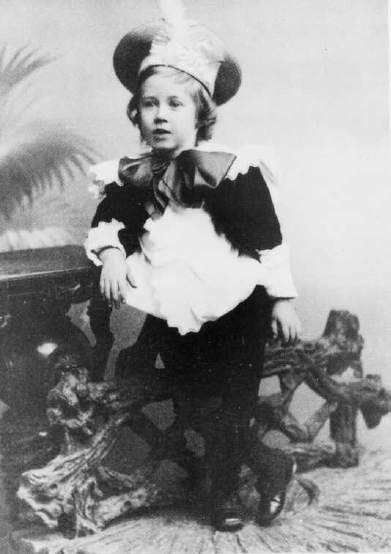
Miller as a child, 1895.
In addition to the unloving ferocity of his mother, his fathers drinking problem and his sisters mental disability, Millers relatives also led lives on the edge. Back in the early 1880s his maternal grandmother went mad and was cared for by Millers This gargantuanism the strong manic, mantic, mystical tendency in Millers character, this volcanic propulsion towards transcendence and illumination is evident in his compulsive esoteric studies. His psychological make-up illustrates the complex relationship between madness, genius, creativity, mystical proclivities and what Richard M. Bucke, an author Miller admired, called cosmic consciousness.

